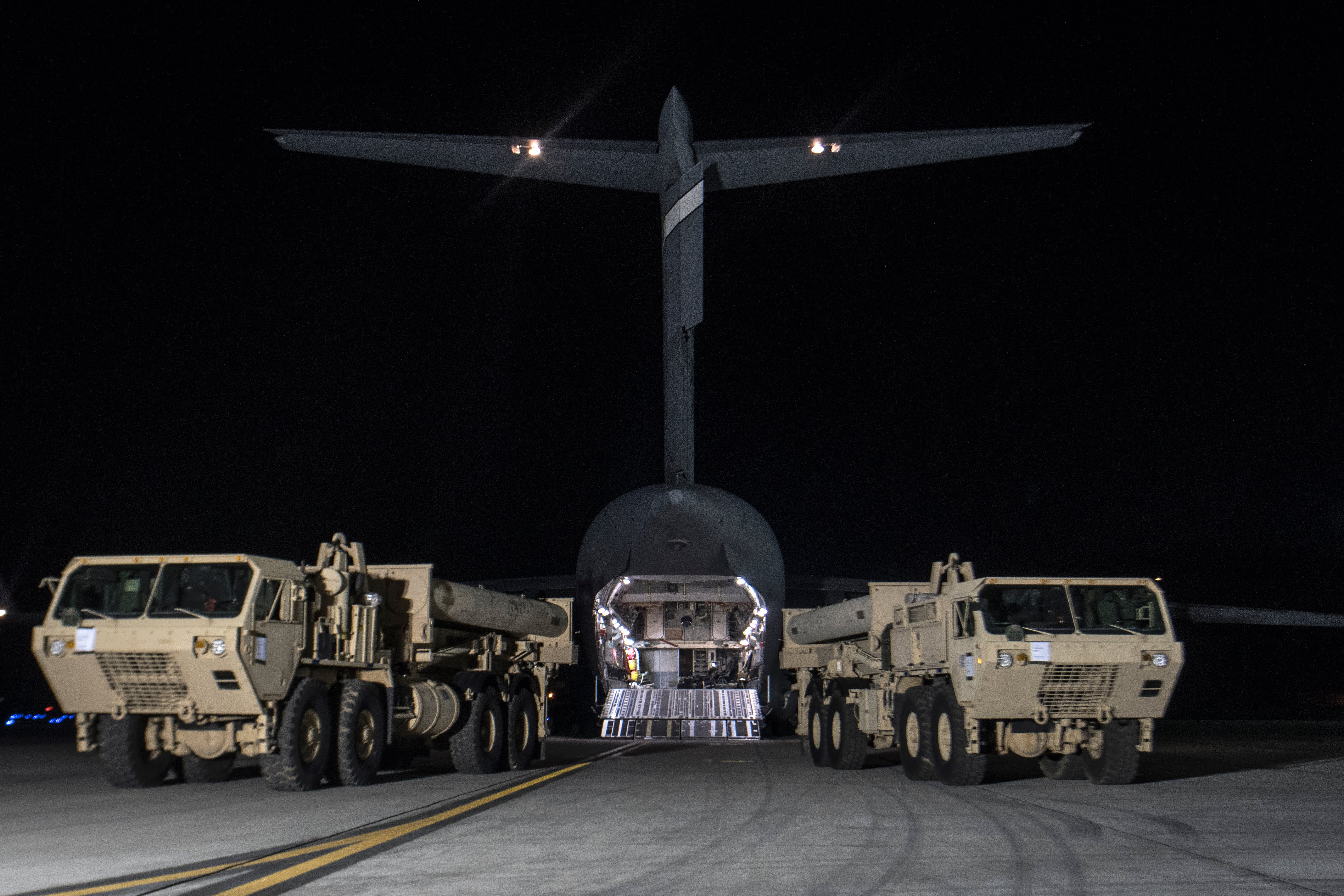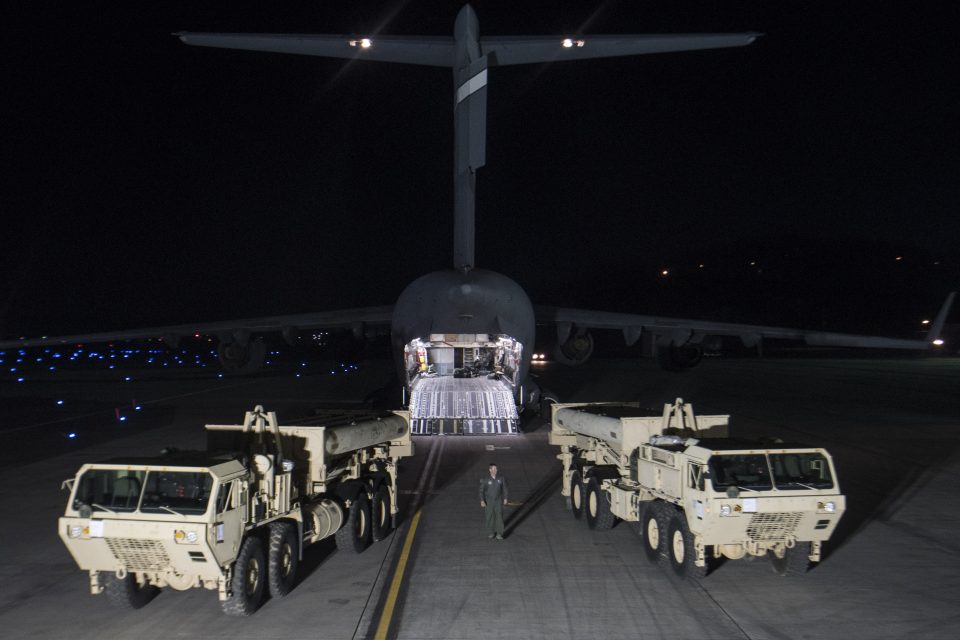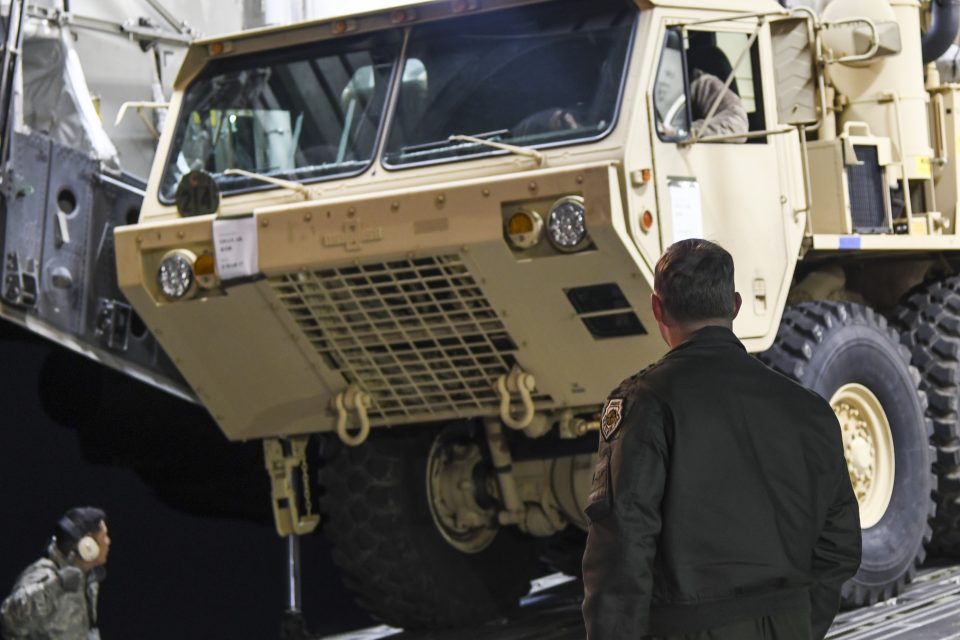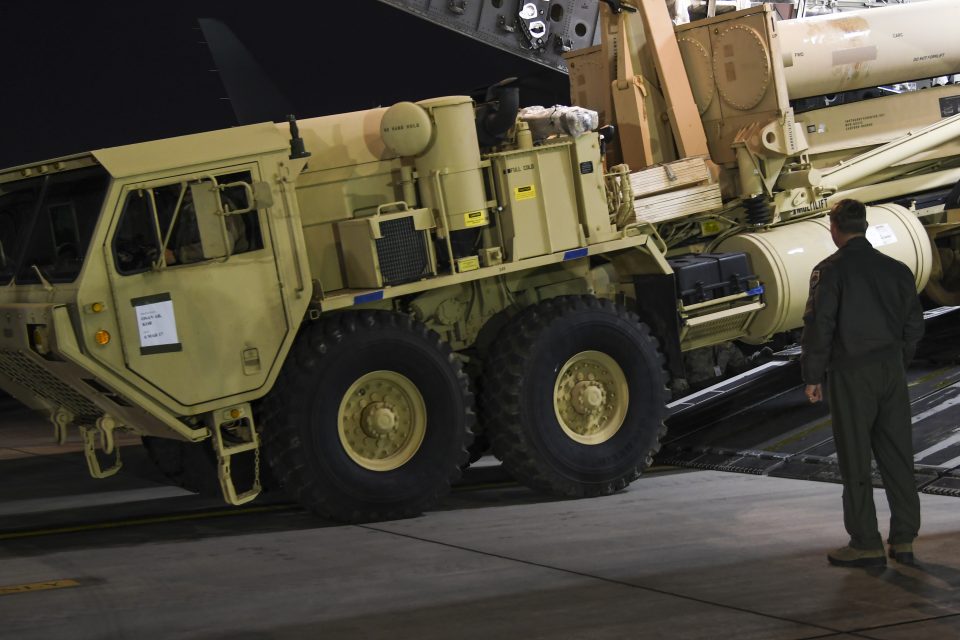2017-03-07 We have written earlier about the coming of THAAD to South Korea.
The Chinese hostile reaction to the deployment tells us more about Chinese intentions with regard to their use of nuclear weapons, than it does about any legitimate diplomatic concerns, which they might have.
As Danny Lam has put it:
Rather than being threatened by a handful of THAAD interceptors, Beijing’s plans for a nuclear missile attack on Japan would be frustrated by far more numerous Patriot and Aegis interceptors.
If they are given sufficient warning to be deployed.
It is well known that PRC have substantial inventories of medium and short range ballistic missiles.
A nuclear ballistic missile first strike offers the opportunity to destroy the conventional arms capability of US and allies in the region in a lighting first strike.
If the PRC actually have thousands of warheads as opposed to 250 alleged by a number of arms control advocates, a nuclear first strike aimed at allied military installations makes sense.
The PRC’s nuclear arsenal is not subject to any arms control agreements, or any credible verification.
Perhaps Beijing is not as toothless or benign as they want the world to believe.
Richard Weitz last year noted that the acquisition of THAAD by South Korea is a first step in what needs to become an integrated defensive capability for the US and its allies in the region.
The decision is welcome but needs to be followed by additional measures to network the ROK, Japan, and the U.S. regional ballistic missile defenses (BMD).
https://sldinfo.com/south-koreas-thaad-decision-needs-follow-on-steps/
And Ed Timperlake has argued that expanding the Army’s role in missile defense is much more significant than adding infantry as part of the warfighting and deterrent posture towards North Korea.
https://sldinfo.com/shaping-a-21st-century-korean-defense-strategy-key-questions-to-address/
Now the South Koreans are moving ahead with their THAAD deployment.
February 27, 2017, the board of South Korea’s Lotte Group approved a land swap agreement with the South Korean military to provide land for the deployment of the United States’ THAAD missile defense system.
The agreement was later signed formally on Tuesday and could allow THAAD to be deployed as early as July of this year.
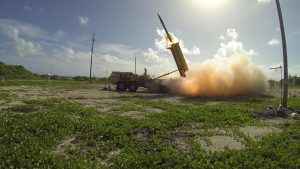 A Terminal High Altitude Area Defense (THAAD) interceptor is launched from a THAAD battery located on Wake Island, during Flight Test Operational (FTO)-02 Event 2a, conducted Nov. 1, 2015. During the test, the THAAD system successfully intercepted two air-launched ballistic missile targets.
A Terminal High Altitude Area Defense (THAAD) interceptor is launched from a THAAD battery located on Wake Island, during Flight Test Operational (FTO)-02 Event 2a, conducted Nov. 1, 2015. During the test, the THAAD system successfully intercepted two air-launched ballistic missile targets.
Now the THAAD system is coming to South Korea.
The first elements of the THAAD system have arrived in South Korea as of March 6, 2017, and the arrival is seen in the video and slideshow below.
THAAD to South Korea. from SldInfo.com on Vimeo.
This has happened in the wake of the most recent North Korean missile launches, which the North Korean leader claims he personally supervised.
According to The Japan Times, the Japanese government considers these latest launches to be increasingly threatening to Japan.
During Monday’s Upper House Budget Committee session, Abe condemned the provocation as “utterly intolerable” and noted the North’s accelerating technological advancements.
“(The test-firing) clearly shows that North Korea is now a new level of threat,” Abe said.
The prime minister also said that “Japan will continue to coordinate closely with the United States, South Korea and other countries to strongly urge North Korea to exercise restraint…..”
The U.S.-made THAAD system is due to be deployed to South Korea later this year. Japan is also reportedly considering bringing in the system.
Monday’s launch also came as the Trump administration is reportedly considering a harder-line approach to the North’s provocations. Trump’s national security deputies have reviewed in recent meetings a range of options to counter the North’s missile threat, The New York Times reported Sunday. Options include direct missile strikes on its launch sites and the possibility of reintroducing nuclear weapons to the South, The Times said.
Those options will soon be presented to Trump and his top national security aides, the report said, quoting U.S. administration officials.
According to a story by the Missile Defense Advocacy Alliance, the importance of the THAAD deployment was highlighted.
With the North Korean ballistic missile threat and the assumption of it being nuclear-capable upon the Korean Peninsula, the United States and the ROK are deploying the most current missile defense systems available and modernizing current capabilities on the Peninsula to defeat this threat and its evolution of complexity, maneuverability, as well as early release of munitions in lofted, depressed and ballistic trajectories.
The overt thrust to improvement of the combined cooperative U.S.-ROK missile defense system is the United States THAAD deployment on the Peninsula, which was finalized yesterday (link to article from Reuters) in a land transfer deal to enable the basing of the THAAD system in the Seongju region.
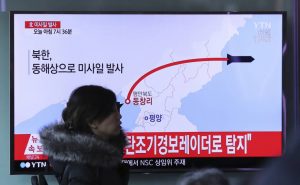
In an official statement released yesterday by the Secretary of Defense Jim Mattis after speaking with the Republic of Korea (ROK) Minister of National Defense Han Min-Koo:
“Secretary Mattis welcomed the official land transfer in Seongju county of Gyeongsangbuk-do from the Lotte Group to the Republic of Korea government. This land transfer will support the alliance’s decision to station Terminal High-Altitude Area Defense (THAAD), a defensive weapons system, in the ROK as soon as feasible. This is a critical measure to defend the ROK people and alliance forces against North Korean missile threats.”
THAAD, is the only single interceptor system in the world today that provides both upper tier in space and lower tier in high altitude of the atmosphere, metal on metal kinetic energy engagement to destroy and defeat incoming complex, multiple reentry vehicles carrying weapons of mass destruction.
Due to its early intercept capability in space for Korea and a layered defense to leverage the natural discrimination of reentry into the atmosphere from space that provides another additional layer of defense for Korea, the THAAD system can defend most if not all of the Republic of Korea and its population of 50 million.
THAAD provides a capability and system that Korea will have by the end of this year in full operation to protect its population from North Korean nuclear ballistic missiles for the first time.
In addition to the THAAD deployment on the Korean Peninsula this year, is the introduction of a new, tested and proven U.S. interceptor capability called the PAC-3 Missile Segment Enhancement (MSE) that will be first operationally deployed within the current two U.S. Patriot battalions in Korea.
The MSE began development in 2003 specifically to counter and defeat the future evolving complex maneuvering ballistic missile threats above the engagement altitude that current PAC-3 interceptors operate at today, and below THAAD engagement battlespace.
The MSE is the world’s most capable endo-atmospheric interceptor with hit-to-kill kinetic energy engagement, a two pulse motor that couples tremendous speed and maneuverability; both allowing the intercept of evolving complex threats inside the atmosphere.
The MSE, with its new patriot launcher the M903, holds 12 interceptors and significantly expands the area defended by current Patriot systems in Korea.
This expansion occurs because PAC-3 MSE’s higher-altitude engagement capability, allowing MSE interceptors to fly within the upgraded Post Deployment Build 8 Patriot Radar ranges.
The MSE interceptor is unique in that it has both C- and X-band capable links built in due to its history as the interceptor for MEADS (Medium Extended Air Defense System), that it has capability to target from both Patriot C-band radars and THAAD X-band radars.
The MSE, in addition to added defense to the current Patriot deployments in Korea, would have inherent capability to target using THAAD radar in Korea that would provide tremendous added capability in range over the Patriot radar, not only to defend the THAAD using current Patriot deployment sites, but to fully exhaust and leverage the MSE full range, providing more shot opportunities and a much-needed layer of coverage to fill the existing gap.
Existing today and below the incoming THAAD system capability and the new MSE are the current Patriot missile defense systems of both ROK and the United States, each with two battalions, are dispersed, deployed and fully operational around the Peninsula that defend and defeat in lower altitudes of engagement.
Because of lower altitude engagement, their defended area is drastically less than the THAAD, and less than the MSE as they can defend key airports and high priority city blocks. With only four Patriot Battalions of capability between the United States and South Korea, the majority of the country has been unable to be physically defended with these systems from North Korea ballistic missiles until this upcoming year.
Beyond the THAAD and MSE, Patriot modernization has not been done in 20 years.
Fully modernizing this current Patriot capability for both countries and adding an additional layer of the interceptor capability to fill the gap of battlespace to intercept between the THAAD and the Patriot, provides more layers, more confidence and more capability to negate and defeat the evolving complex missile threat of North Korea.
Innovation of U.S. Army leadership on the Korean Peninsula has driven Patriot modernization, which requires replacement of major equipment, going from out dated 1970s analog to current modern digital systems; baseline configuration for the future IBCS and 360 radars implementation, significant hardware and software upgrades, as well as increasing the Patriot radar capability to manage the new MSE interceptor.
Patriot modernization will take place this year on the Korean Peninsula while maintaining air and missile defense operations, rather than modernizing in the United States and removing an entire Army Air Defense Artillery (ADA) Battalion from the global rotation, which is already overcommitted. The Patriot modernization depot on Suwon Air Base, Korea is the first in refitting and modernizing Patriot battery units in theater worldwide as demonstrated from the two deployed operational U.S. ADA Battalions in Korea.
The challenging overload and overmatch of the evolving complexity of the North Korean ballistic missile threat as continued to be demonstrated by the test on February 12th, has to be countered, neutralized and defeated by the United States, the Republic of Korea and Japan for the security and safety of these three allies.
Having the wisdom of leadership of excellence to integrate and apply current missile defense capabilities is a game changer for deterring the calculus of North Korea, providing active defense to the populations of the region, and sending strong strategic message of collaboration between South Korea and the United States.
http://missiledefenseadvocacy.org/alert/in-defense-of-korea/
Editor’s Note: We were among the first to focus on THAAD in the Pacific and did so through an interview with the THAAD Commander on Guam in 2014 which we reproduce below,
2014-01-02 The emergence of the second nuclear age is one of the core challenges facing the US and allied forces in this decade of the 21st century.
Successfully navigating these challenges is not a given, and shaping an effective response is a work in progress.
During 2014, our Second Line of Defense Forum will focus initially on the challenge of the Second Nuclear Age and our guest editor will by Paul Bracken, the author of a book with the same name.
The core point is rather simply put: the rules that applied to the first nuclear age do not necessarily apply to the second.
The new nuclear powers are acquiring nuclear weapons or on paths to obtain them as part of a re-shaping of global dynamics within the 21st century and to re-shape global power balances.
Rather than relegating nuclear weapons to the dust bin of history, the new nuclear powers are seeking to make them center pieces of their global aspirations and ability to position themselves within their regions and beyond.
In his presentation to the Air Force Association Pacific Forum, the PACAF Commander, General Hawk Carlisle, highlighted the contribution made by the US Army in moving a THAAD Battery to Guam in record time.
Instead of a 6 week deployment cycle, the battalion was moved and operational in two weeks time!
We had a chance to follow up on Carlisle’s introduction of the subject with an phone interview with Task Force Talon Commander, LTC Cochrane, the THADD Task Force commander who is currently based on Guam. Cochrane has been in the US Army for 26 years, six and half years as an enlisted air defense solider and the remainder of the time as an air defense officer. He has spent the majority of his career in divisional units, doing short range air defense.
According to LTC Cochrane: The task force itself is comprised of about 205 soldiers.
There are several different elements to the task force.
The first, of course, is the THAAD battery. This is Alpha 4, THAAD battery out of Fort Bliss, Texas.
Additionally, I have a security element that is out of the 472nd MP Company, out of Fort Wainwright, Alaska.
I also have a couple of different communications elements from units based out of Hawaii and, I do have a captain here from 1-1 ADA in Okinawa.
So, we really are pulling the best from multiple different units to accomplish this mission because we are in a deployment status here on the island of Guam.
SLD: What is your mission?
Lt. Col. Cochrane: The mission here is to defend the island of Guam against the North Korean tactical ballistic missile threats. If the strategic deterrent should fail, our task is to intercept North Korean ballistic missiles. We are here to defend the entire island of Guam.
SLD: General Carlisle highlighted the rapidity of your deployment and considered this a key part of the deterrent structure. Could you discuss the approach?
Lt. Col. Cochrane: This was the first ever deployment of THAAD.
We had a planning timeline of about six weeks to get to any place in the world and to set up and be operational.
We looked at that planning cycle and said: “You know we can do better than that.”
With a real mission on the table, the intensity picked up. We cut the deployment time by 2/3s and pulled in the elements from different locations into an integrated and coordinated force with the Air Force and with Joint Region Marianas (JRM). We were successful because the Air Force, the Navy and the Army pulled together as a joint force.
http://www.cnic.navy.mil/regions/jrm.html
We initially moved what we call a minimum engagement package by air to Anderson Air Force base. It came in a very rapid timeline on a relatively small number of aircraft (C-17s and C-5s) and allowed us to establish our basic operation and to achieve our initial capability to defend the island. The remainder of the equipment came by sea.
A clear theme in the discussion was how the workings of the joint force or what General Carlisle referred to as cross-domain synergy was a key element to shaping capabilities for the second nuclear age.
Lt. Col. Cochrane: Missile defense is more than just one platform or system. It is a classic case of what you call no platform fights alone. It is a system of systems.
We combine Aegis, with THAAD with short-range defense systems, etc.
For example, at Hickam Air Force Base in Hawaii, the 94th AAMDC and the 613 AOC coordinate air and missile defense fot the Pacific Theater. The Navy and the Air Force all come together and conduct that coordination in terms of how we protect and coordinate our defense so that we are maximizing our capabilities.
It is not just a single system standing alone or operating independently.
It is the inter-dependence and the inter-operability of all these systems to all three of the branches that are actively engaged in missile and air defense.
In my unit, we are looking aggressively at how to cross link with Aegis, for example.
I have been extremely fortunate that Brigadier General Garland, who is the commander of the 36th Wing here has emphasized: “Welcome to Guam. What do you need?”
He has put his wing and their resources at our disposal to execute our mission so when we first came in, we were welcomed with open arms by our Air Force brethren and we are now part of their family.
We interact with the wing commander and the wing vice-commander routinely, several times a week, talking about these missile defense issues.
Additionally, we are integrated into Wing exercises to practice coordinated actions before, during and after TBM engagements.
And we clearly do not want the Aegis and the THAAD firing against the same inbounds just because then we are wasting ammunition on two very capable missiles when they can be used elsewhere.
This is where the jointness of this whole process must come into play.
As we get to this “purple force” concept where all of us are working under a joint task force or a joint commander, it becomes extremely important that we actually do that cross coordination.
I believe that missile defense is only going to become more important as we continue to rebalance to the Pacific strategy that has been directed on us.
I think you are going to end up seeing more and more emphasis on the continued growth of our cooperative joint-ness between the Navy (Aegis ships), the Air Force (Defensive Counter Air) and the Army (Air and Missile Defense).
SLD: In fact, your entire effort is part of what we have referred to as the Second Nuclear Age.
Lt. Col. Cochrane: It is clear that our operational capabilities are important in and of themselves and as part of strategic messaging to North Korea and to our allies and friends.
We tell them, “We are capable. You threaten this island specifically, we are going to defend this island,” and by doing so we are not only sending a strategic message only to North Korea but also to other friends and allies in the area and any potential adversaries.
Editor’s Note: Perhaps the Iron Dome might be added to the defense mix in South Korea.
https://sldinfo.com/israels-iron-dome-an-initial-assessment/


